5: Finding the Right Digital Edges
A digital edge comes from creating new combinations of digital and physical resources, not simply substituting one for the other. Physical resources, or ‘atoms’ as Negroponte called them, include the personnel in the organization, the equipment and communications devices they use, the facilities they work in, the inventory and raw materials, the physical products and services produced. If one can see, touch, smell, or taste it, or it winds up on the company’s balance sheet, then chances are it is a physical resource.
A digital resource includes anything with a chip in it. However, this is a biased definition, emphasizing the physical implementation of technology — the chip. An actionable definition of digital resources includes information, how it’s captured, how it’s processed and the new insight created in that process. The combination captures the essence of digital resources used to create an edge. Examples of digital resources include customer information and history, product descriptions, operational performance, awareness of the current situation, telemetry from sensors, channels, social insights and understanding, analytics, commitments and contracts, designs and other forms of intellectual property, motivations, experiences, preferences, and more.
Bringing physical and digital resources together into a digital edge requires thinking about the relationship and resources that flow between the physical and digital worlds. The process begins by understanding the customer- or process-oriented outcome and then thinking of the set of digital capabilities required to achieve that outcome in ways that lead to digital value. A company forms its digital capabilities by creating innovative combinations of physical and digital resources. To create these innovative combinations, companies must explore how best to extract information from physical resources and infuse that information, and additional sources as well, back into those resources; thus developing a new digital edge. This process is illustrated in Figure 5.1.
Figure 5.1 Building Digital Edge Capabilities by Innovating, Extracting and Infusing Information
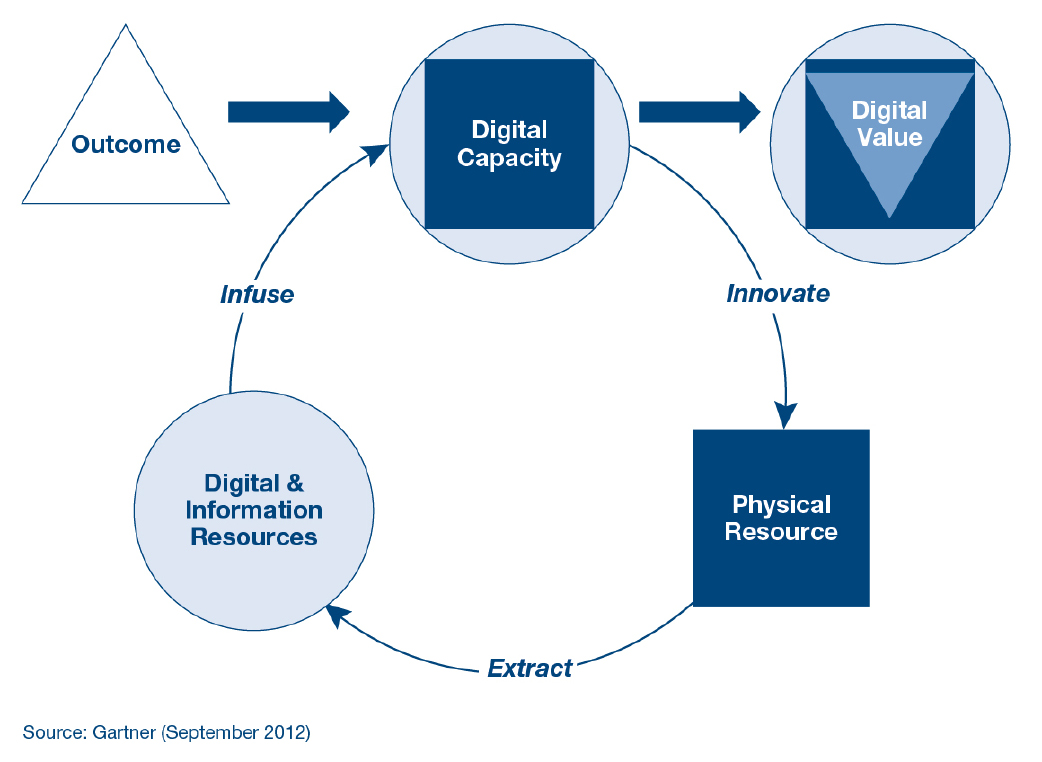
Extract and Infuse to Build Digital Capability
Creating digital capability involves extracting two types of information from physical resources. The first, static information, includes descriptions such as characteristics, components and relationships with other resources, and formed the basis of e-commerce. Analytics, master data management and content management technologies extract static information. The second type, dynamic information, includes a resource’s location, its condition (i.e., temperature, positional orientation, exposure to physical shock), pricing, availability, and more. Digital technologies such as sensors, near-field communications, wireless communications and embedded chips extract dynamic information. Extraction is the foundation for e-commerce as companies put extracted information online. Creating a digital capability requires using information to give physical resources and other data new performance and value characteristics. Those characteristics come from infusing information back into the physical world.
Infusion creates new capabilities by driving information and digital resources back into physical resources. The resulting combination forms the basis for a digital edge because it connects previously isolated operations and makes dumb resources smarter. For example, infusing location, patient, scheduling and test information into the medical equipment at Children’s Hospital of Los Angeles not only raises its utilization — everyone knows where the equipment is and what it is doing next — but also plays an important role in eliminating information gaps as a cause of patient harm. A range of technologies, including mobile and tablet computing, digital signage, remote sensing, analytics, software as a service, social media and broadband communications, make infusion possible.
Innovation comes from the resulting capability and its ability to create the desired outcome. The innovations in terms of customer experience, company operational capabilities and operational performance discussed throughout the book illustrate some new answers to achieving outcomes based on creative combinations of digital and physical resources. The process of blending the two to create innovative solutions is the focus of Chapter 12.
The IONX Solution Provides Continuous Information About Rail Car Status
To illustrate extraction and infusion, let’s consider one scenario: rail cars. The vast majority of the more than 1.5 million railroad freight cars in the United States — a significant part of the national supply chain — run in “radio silence.” Railroad operators assume they know where they are, what they carry, and their status based on shipping and train-dispatch records. The railroad periodically (and manually) verifies rail cars when they move to a siding or reach their destinations. 1
In 2008, Amsted Rail Company started a subsidiary, IONX, headquartered in West Chester, Pennsylvania, to develop machine-to-machine (M2M) remote tracking and condition-monitoring solutions for freight cars, locomotives, ISO tanks, containers and chassis. The systems use both satellite and cellular communication technologies to extract and infuse information into the previously “silent” system, opening the door to innovative approaches to rail distribution and commerce (for example, using rail car telemetry as a trigger to invoicing and payment processes).
The initial outcome for developing the IONX system was “monitoring what we make,” according to Mike McDonnell, chief technology officer of Amsted Rail. To achieve this, IONX created a digital capability to pinpoint a freight car’s location, its operating condition and the condition of its cargo. This, in turn, differentiates IONX’s and Amsted’s products from competitors because an IONX digitally enabled rail car enhances railroad safety, improves rail car utilization, reduces operating capital requirements, and improves regulatory compliance and supply chain operations.
To achieve this, IONX deploys a combination of digital and physical resources to create value at the level of both the rail car and the entire railroad operation. At the rail car level, sensors attached to the rail car provide real-time knowledge to the railroad via wireless, GPS, RF and satellite communications. Each rail car can have multiple sensors within and outside it, creating a hub for a mesh network of sensors providing comprehensive information on conditions such as temperature, weight, movement and pressure, and others that monitor types of cargo, such as liquid, volatile or refrigerated. Due to the harsh environment, sensors are rugged and self-powered (including solar-powered units), requiring no structural modification of the rail car or the communications network.
A smart rail car is only valuable if it can infuse information as part of a digitally enabled railroad. IONX has created digital technology that works within the real constraints of current rail operations. Its remote sensors attach to existing rail cars, use existing communications infrastructure and provide information that feeds existing operational systems. This is a marked departure from other digital applications that require creating specialized environments for digital technology.
Realizing these capabilities within the limitations of current rail operations required building additional digital capabilities that leverage sensor data into specific operational value and revenue. IONX services include rail car asset-monitoring systems that provide analytics and dispatch support. Additional services link rail car information with ERP systems to track assets, handle billing and automatically generate bills as rail cars are offloaded. The company provides these services via a cloud service model that enables railroads to incorporate them quickly and efficiently.
IONX’s combination of digital technology at the rail car level and digital services across the railroad create customer value by impacting related business processes such as:
• Improved fleet management, as enhanced information on rail car status creates new capabilities to address safety, security and cycle time performance more effectively
• Better asset management and utilization owing to asset location via GPS, and dynamic geofencing-based reporting
• Improved operational safety, because the rail operator and customer can monitor ride quality, speed, disruptions and other factors
• Increased operator ability to comply with regulations and reporting requirements
• Improved equipment availability and uptime, since the sensor network monitors critical conditions (e.g., temperature and physical status)
IONX found the right digital edges to create customer value and company revenue. In this case, the company applied digital sensor and communications technology to give each rail car a “voice.” The company automated the processing of digital resources to give its railroad customers the tools to turn information into value.
Innovation Amplifies Digital Capabilities
Inanimate objects are not the only properties that can be extracted and infused. Location-based services such as Square’s 2 Pay with Square represent another source of digital capability. Square uses GPS to detect individuals shopping in a store and presents their photos on a cashier’s iPad Register app. When a customer is ready to pay, she simply states her name and the cashier immediately debits her account. No cash is handled in the transaction. The digital essence of the customer — her photograph — is infused into the retail process to create a digital capability, thus amplifying the cashier’s standard process.
Innovation leads to further innovation as digital capabilities access and act on digital information to create new sources of value. For example, because Pay with Square can detect shoppers in a store, it can also detect them in the general neighborhood and draw them into the store with promotional offers. Similarly, Royal Caribbean captures an authenticated digital image of each customer’s face when passengers initially board the ship. This image is part of the digital platform. This is part of a ”happy surprise” phenomenon observed in a number of case study companies profiled in this book — digital innovations built on each other in ways that could not be predicted in the digital strategy.
Five Models of a Digital Edge
Extract, infuse and innovate represent the model for creating digital capabilities through new combinations of physical and digital resources. Categorizing the infinite range of technologies and possible combinations into a finite set of models requires distilling different models into their most fundamental elements. Rather than classifying the elements by type of technology — mobility, big data analytics, social media, etc.— that change rapidly; the model describes the relationships between physical and digital resources. Those relationships describe different digital edges shown in Figure 5.2. This graphic, introduced in the first chapter, displays the five different models.
Figure 5.2 Five Models of a Digital Edge

Graphical attempts to categorize the diversity of potential digital solutions are bound to face limitations. Figure 5.2 provides a graphical listing of the different types of digital edge in terms of the relationships between digital and physical resources. Although these models build on one another, they are not intended to represent increasing digital maturity.
The arrow highlights the resource at the forefront of a digital edge. For example, in the Automate model, digital technologies are the primary source of competitive value. In the Accompany model, digital resources support physical resources. The Abstract model rests on a “digital on digital” relationship reflecting the creation and application of derivative information. Facebook is an example of this model, as it creates value from building information from individuals into more valuable aggregate information, which it calls the human graphic. Royal Caribbean’s use of information to shape individual behavior and decisions that collectively shape everyone’s experience is another example of this solution. Figure 5.3 summarizes the description of each model.
Figure 5.3 Characteristics of the Models of a Digital Edge
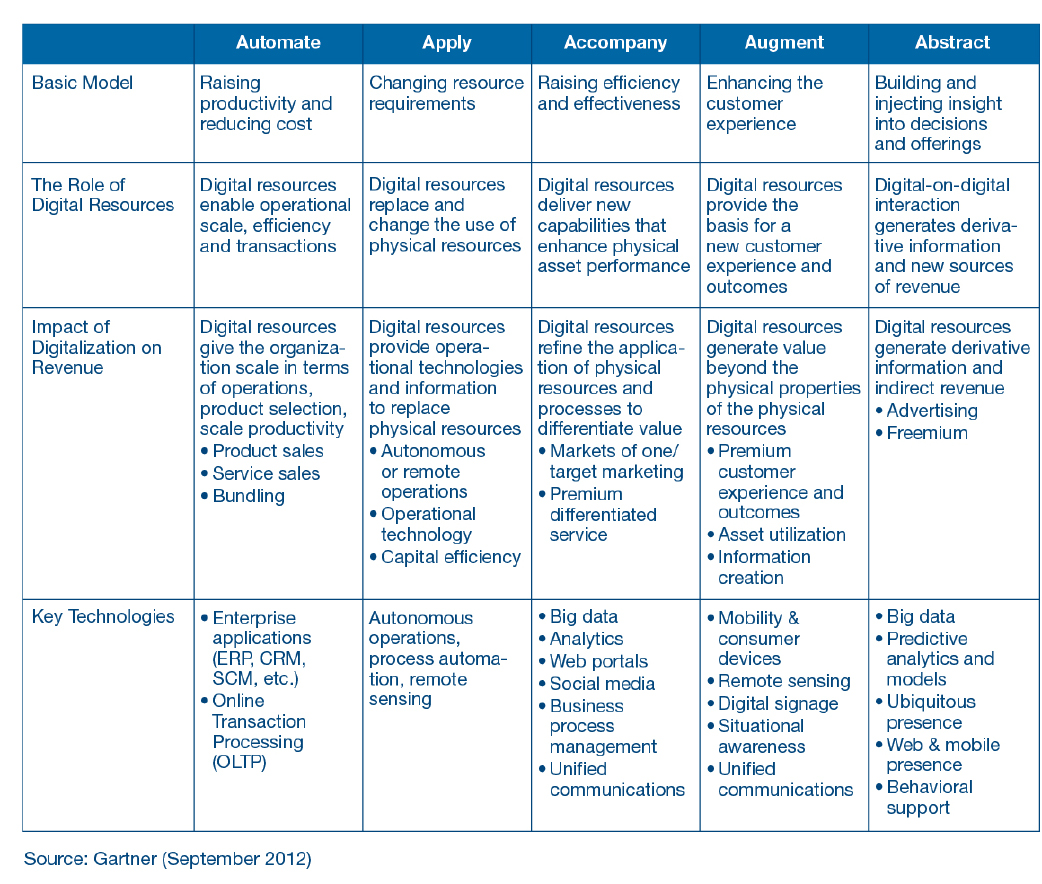
Mapping the Different Solutions
A digital edge rests on more than the relationship between physical and digital resources. Organizations can achieve similar goals with different types of digitalization. However, each type reflects a particular focus on strategy planning, customers, operations or financial impact. Mapping these focus areas to the different models creates a map that helps identify the opportunities and applications of digital capability (see Figure 5.4).
Figure 5.4. A Map of the Models of a Digital Edge
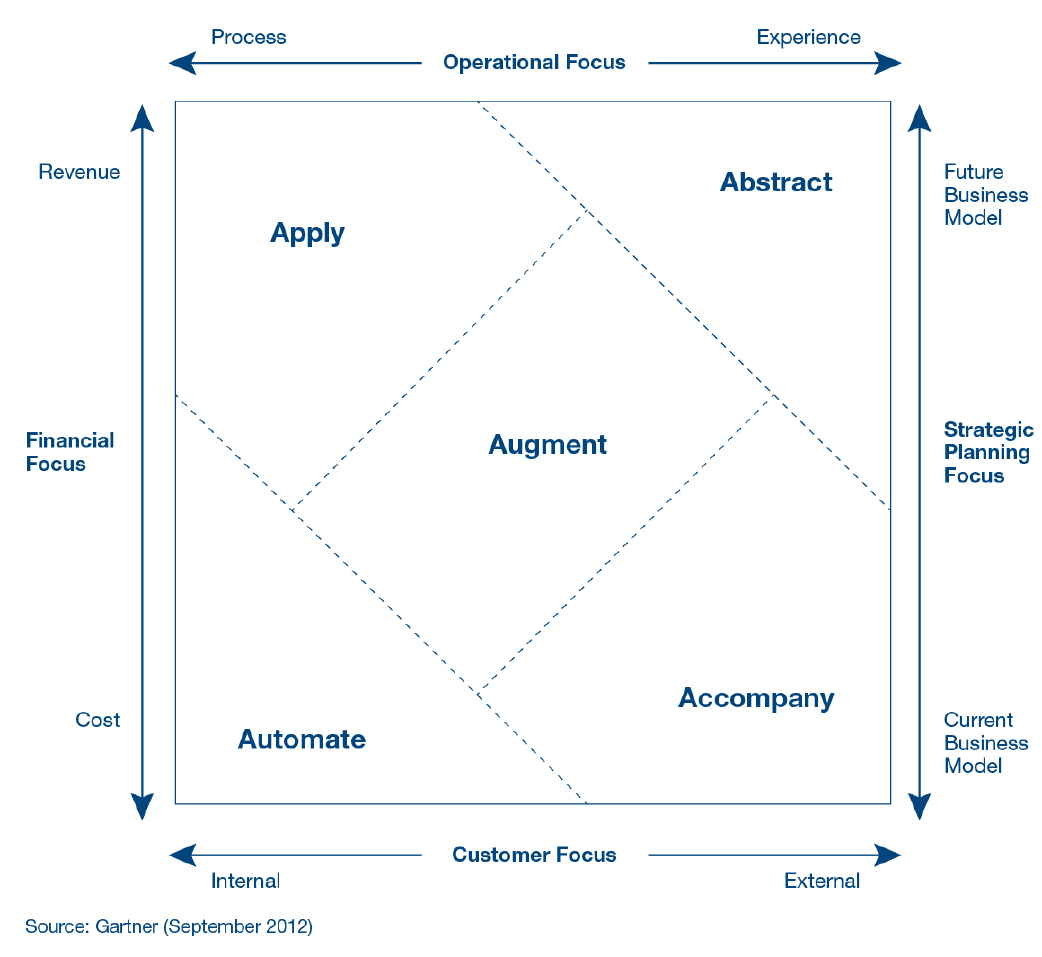
These digital models represent a mosaic, not a monochromatic solution. Firms creating a digital edge will use the models in combination to achieve their strategy. For example, IONX’s digital solution incorporates solutions based on the Automate, Apply and Abstract models. The specific boundaries and positioning of each digital capability solution in the map illustrate, rather than prescribe, each model’s impact on the organization. Use this positioning to help select the right model to achieve each outcome in the digital strategy.
For example, FedEx Ground’s need to increase the efficiency and capacity of its package-sorting processes may be best met by starting with an Automate model of digital capability. Select a model as a starting point for each of the major outcomes within a digital strategy, then adjust as necessary. Figure 5.5 translates this map into specific directions as to which models are best suited to achieve the outcome based on the required focus.
Figure 5.5 Selecting a Starting Point for Digital
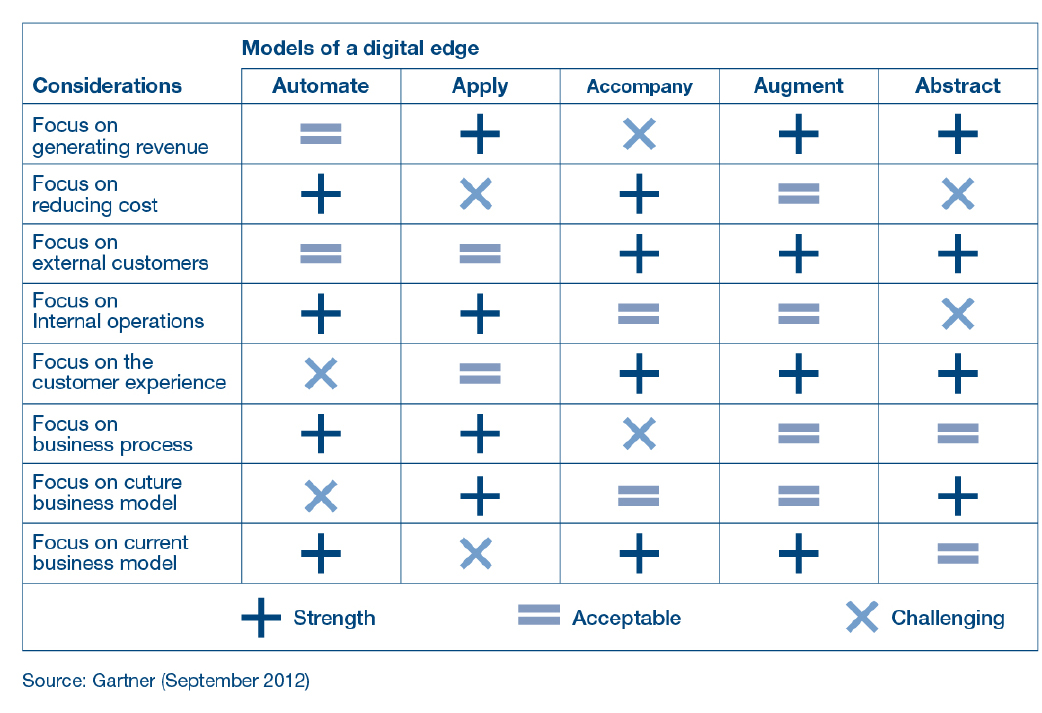
Creating a Digital Enterprise Platform That Supports Each Type of Digital Edge
An effective digital strategy uses different types of digital edge to achieve its intended outcomes. In that regard, the different models of a digital edge represent a pallet of colors that come together, through the strategy, into a digital picture of the organization’s digital capabilities. That digital platform, outlined in Figure 5.6, represents the structures an organization uses to create value and revenue via digital technology. The digital platform supports the enterprise and every type of digital edge. The model summarizes the structures involved in creating a digital organization. Like any model, it is subject to change in the face of new technologies, so consider it as a guideline rather than a hard and fast inventory or list.
Figure 5.6 A Model of an Enterprise Digital Platform
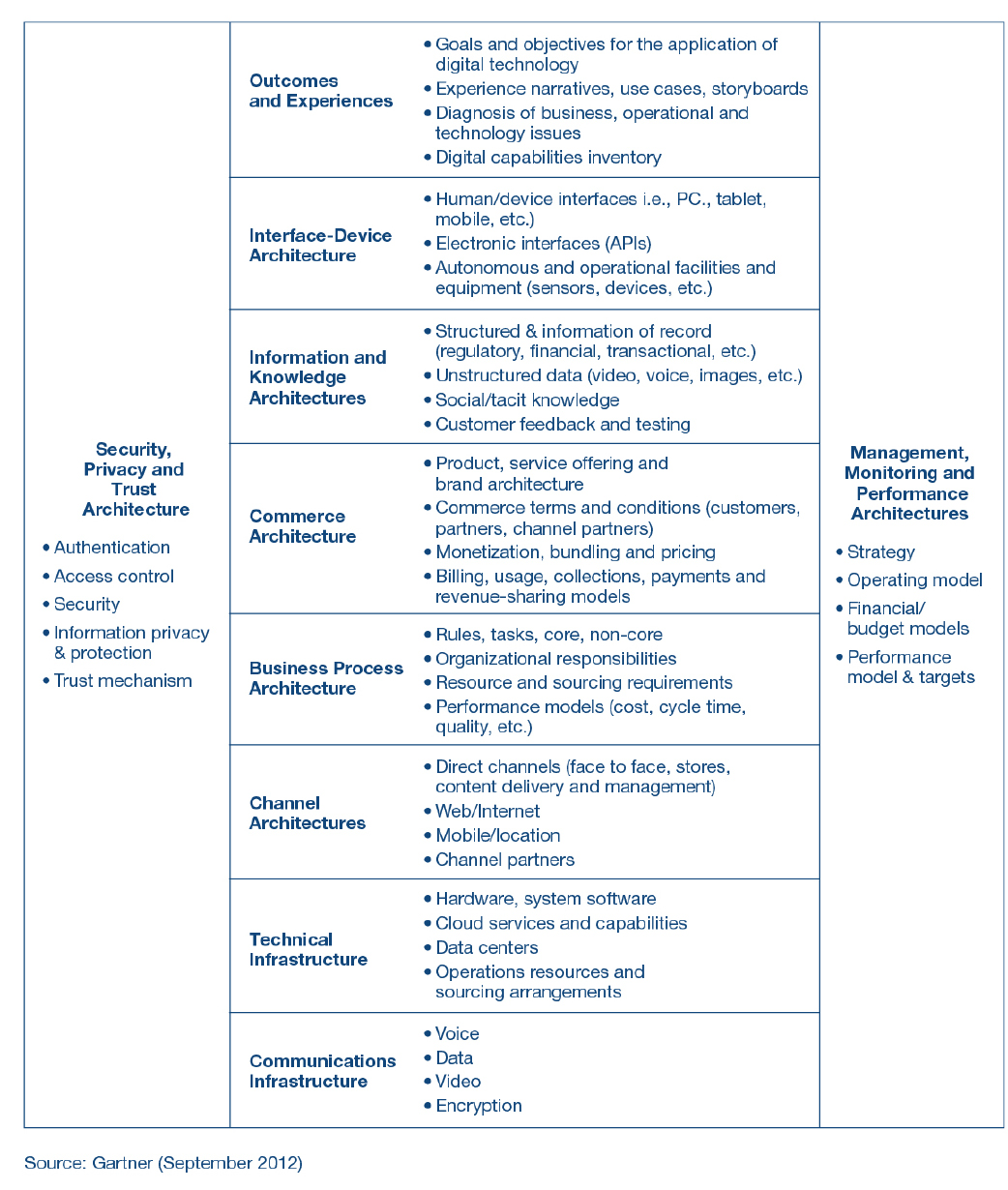
Use Figure 5.6 to set your organization’s digital strategy. An enterprise digital platform covers the range of structures involved in a digital organization, regardless of their source. In talking about this digital platform, Hung LeHong, vice president, Gartner Research, pointed out that it is important to recognize that parts of the platform will not belong to or be controlled by the company.3 This point goes beyond simple notions of outsourcing or contracting with suppliers. For example, where customers previously carried out self-service activities on company-supplied equipment, they will increasingly perform the same tasks using their own devices or even third-party applications. A digital platform therefore bleeds out of the enterprise’s four walls and into the consumer’s/citizen’s/employee’s personal platform, particularly in terms of the structures involved in achieving customer outcomes — the interfaces, devices and channel platforms. Companies do not have to build these platforms, a benefit, but they still need to architect them.
Explore the Different Models of a Digital Edge
The models of a digital edge provide a starting point for the design and deployment of digital capabilities that create customer accessible value and company addressable revenue. These digital capabilities extract information from physical resources and infuse it with other information into innovative new solutions. IONX provided an example of the range of solutions required, from remote sensors to analytics solutions to software delivered via a cloud-based model. This is a great example of building a digital edge. The next five chapters explore each of these digital edge models, provide additional examples and describe how to create a particular type of digital edge.